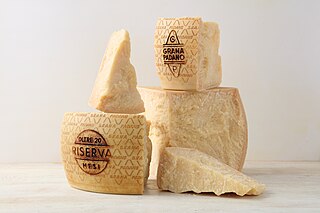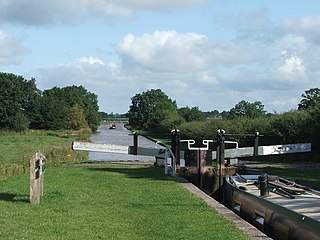
Cheddar cheese is a natural cheese that is relatively hard, off-white, and sometimes sharp-tasting. It originates from the English village of Cheddar in Somerset, southwest England.

Nantwich is a market town and civil parish in the unitary authority of Cheshire East in Cheshire, England. It has among the highest concentrations of listed buildings in England, with notably good examples of Tudor and Georgian architecture. It had a population of 14,045 in 2021.

Stilton is an English cheese, produced in two varieties: Blue, which has Penicillium roqueforti added to generate a characteristic smell and taste, and White, which does not. Both have been granted the status of a protected designation of origin (PDO) by the European Commission, requiring that only such cheese produced in the three counties of Derbyshire, Leicestershire and Nottinghamshire may be called Stilton. The cheese takes its name from the village of Stilton, now in Cambridgeshire, where it has long been sold, but cannot be made because it is not in one of the three permitted counties.

Caerphilly is a hard, crumbly white cheese that originated in the area around the town of Caerphilly, Wales. It is thought to have been created to provide food for the local coal miners. The Caerphilly of that period had a greater moisture content, and was made in local farms. At the start of the 20th century, competition for milk in the local area saw production decline, and Caerphilly production was gradually relocated to England.

Red Leicester is an English cheese similar to Cheddar cheese, but crumbly in texture. It is typically aged 6 to 12 months. The rind is reddish-orange with a powdery mould on it. Since the 18th century, it has been coloured orange by the addition of annatto extract during manufacture. It is a cow's milk cheese, and is named after the city of Leicester, or the ceremonial county it is located in, Leicestershire.

Lancashire is an English cow's-milk cheese from the county of Lancashire. There are three distinct varieties of Lancashire cheese. Young Creamy Lancashire and mature Tasty Lancashire are produced by a traditional method, whereas Crumbly Lancashire is a more recent creation suitable for mass production.

Stilton is a village and civil parish in Cambridgeshire, England, about 12 miles (19 km) north of Huntingdon in Huntingdonshire, which is a non-metropolitan district of Cambridgeshire as well as a historic county of England.

Gloucester is a traditional, semi-hard cheese which has been made in Gloucestershire, England, since the 16th century. There are two varieties of the cheese, Single and Double; both are traditionally made from milk from Gloucester cattle. Both types have a natural rind and a hard texture, but Single Gloucester is more crumbly, lighter in texture and lower in fat. Double Gloucester is allowed to age for longer periods than Single, and it has a stronger and more savoury flavour. It is also slightly firmer. The flower known as lady's bedstraw was responsible for the distinctively yellow colour of Double Gloucester cheese.

Grana Padano is a cheese originating in the Po Valley, in northern Italy, similar to Parmesan. There are less strict regulations governing its production compared to Parmesan. This hard, crumbly-textured cheese is made with unpasteurized cows' milk that is semi-skimmed through a natural creaming process. To preserve the authenticity of the manufacturing processes and raw materials used to make this cheese, Grana Padano is registered as Geographical Indication in Italy since 1954 and as a European Union protected designation of origin (PDO) since 1996, and is protected in several other countries based on the Lisbon Agreement and bilateral agreements.

Acton is a small village and former civil parish, now in the parish of Burland and Acton, lying immediately west of the town of Nantwich, in the unitary authority area of Cheshire East and the ceremonial county of Cheshire, England. The civil parish covered 762 acres (3.08 km2) and also included the small settlement of Dorfold and part of Burford, with an estimated population of 340 in 2006. It is administered jointly with the adjacent civil parishes of Henhull and Edleston. Historically, Acton refers to a township and also to an ancient parish in the Nantwich Hundred covering a wide area to the west of Nantwich. The area is agricultural, with dairy farming the main industry. Around a third of the area falls within the Dorfold Estate. Historically, agriculture was the major employer, but it has now been overtaken by the service industries, with many residents commuting significant distances outside the parish to work.

Baddington is a civil parish in the unitary authority of Cheshire East and the ceremonial county of Cheshire, England, which lies immediately to the south-west of Nantwich and north of Audlem. Predominantly rural with scattered farms, the civil parish has a total population of around 100 people, increasing to 212 at the 2011 Census, and includes the dispersed settlement of Hack Green, the site of a former RAF decoy station, radar station and Home Defence regional headquarters. Nearby villages include Aston, Broomhall Green, Hankelow, Ravensmoor, Sound Heath and Stapeley.

Shropshire Blue is a cow's milk cheese made in the United Kingdom.

Cheese is a dairy product produced in a range of flavors, textures, and forms by coagulation of the milk protein casein. It comprises proteins and fat from milk. During production, milk is usually acidified and either the enzymes of rennet or bacterial enzymes with similar activity are added to cause the casein to coagulate. The solid curds are then separated from the liquid whey and pressed into finished cheese. Some cheeses have aromatic molds on the rind, the outer layer, or throughout.

Henhull is a former civil parish, now in the parishes of Burland and Acton and Nantwich, in the unitary authority area of Cheshire East and the ceremonial county of Cheshire, England, which lies to the north west of Nantwich. For administrative purposes, was is combined with adjacent civil parishes of Acton and Edleston to form a total area of 765 hectares. The parish was predominantly rural with scattered farms and houses and no large settlements. In 2019 a 1,100-house development called Kingsbourne was being built in the east of the parish as an extension to the town of Nantwich. Henhull civil parish also included the hamlets of Basin End, Bluestone, Welshmen's Green and part of Burford. Nearby villages include Acton and Rease Heath.

Florence Lucy Appleby MBE was an English traditional cheesemaker. She created 'Mrs Appleby's Cheshire' which, by the time of her death, was the last remaining Cheshire cheese to observe the traditions of using unpasteurised milk from the farm herd, being bound in calico cloth and matured on-farm. Appleby co-founded the Specialist Cheesemakers Association to defend the use of unpasteurised milk in cheesemaking.
Agriculture has historically been the primary industry of the English county of Cheshire. Dairy farming has predominated, and the county was particularly known for cheese-making.
Milk Link was a large dairy company in the United Kingdom. It was the UK's largest dairy cooperative and the UK's largest producer of cheese. In 2012 the company merged with Arla Foods.

Oxford Blue is a variety and brand of blue cheese produced in Burford, Oxfordshire, England in 1995 by French baron Robert Pouget in the tradition of Stilton cheese but with a creamier consistency especially when the cheese was allowed to mature. It is a soft and creamy cheese that has tangy, aromatic and spicy qualities. By 2013, around five tonnes were produced monthly.
















